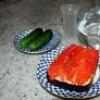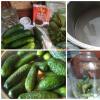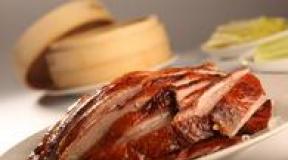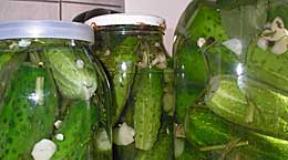How to remove mucus from fresh fish. How to clean the sterlet and cut it for cooking various dishes
The usual picture after cleaning fish - scales throughout the kitchen and nervous hostess. Even worse, if she does not know how to approach the fish at all.
How to remove offal
- It is desirable to gut fish and remove scales from it at the same time (at least on the same day).
- Need a cutting board. To prevent the smell of fish from eating into it and to speed up the process of subsequent cleaning, a bag or newspaper is put on the board.
- Holding the fish belly down, you need to make a cut on it from head to tail.
- Remove the contents with a spoon or knife.
- On the walls of the belly is a dark film that must be removed.
- Thoroughly wash the fish.
How to get rid of scales

- If the fish is slippery (after defrosting), it is necessary to wash it. In addition, if hands sprinkle with salt, the fish will not slip. You can hold it with a towel.
- It will take a large bowl (bowl, bowl), in which the fish is placed entirely. To ensure the preservation of cleanliness in the kitchen, you can clean the fish in a package of dense polyethylene under running water.
- We wet the fish with dried scales with water, wait a few minutes and clean.
- First of all, you need to cut off the sharp fins and head (if it is not in the recipe).
- The scales are removed using a special grater, knife, fork and even a teaspoon.
- You need to clean the scales from tail to head, that is, against its growth. Shallow sharp movements begin cleaning. First you need to clear the sides, and then the belly.
- After washing the fish, we get rid of the stuck scales and evaluate the quality of work.
If the fish is supposed to be boiled or smoked, you can not clean the scales. This will save more nutrients. In addition, you can buy an already cleaned fish. I recommend also to try.
Fish cleaning
It is necessary to consider the way how to quickly and properly clean the fish depends on its features. In particular, mackerel and flatfish have no scales. In burbot and catfish it is very small, almost imperceptible. The strongest scales are in perch, crucian carp, carp and perch.
Perch

It is very difficult to clean the scales of the perch, so the cheekbone is removed along with the skin.
Zander

The fin on the back of the perch is very hard. We cut fish under and above the fin, after which it can be removed.
Horse mackerel

Before cleaning, you need to dip into boiling water for thirty seconds, because the scales are very rigid.
Catfish

After gutting, removal of the head and fins, it is necessary to divide the fish into fillets from which to remove the skin.
Burbot, eel

Around the head to make an incision and remove the skin as a stocking. When gutting, the liver of burbot is separated and cooked separately.
Tench

The tench has thick and small scales covered with mucus, which makes cleaning very difficult. First you need to put the fish in boiling water, then in cold water. Now you can clean the mucus, scales and gut.
Hake

It is necessary to clear small scales and remove the abdominal film. The skin of a large fish is coarse, so take it off.
Som

It is necessary to clear mucus, gut and cut off the head with fins. If the fish is very large, it can be cut before removing the skin.
Cod

The liver is eaten. There is an abdominal film that needs to be removed.
Lamprey

This fish is not gutted. After cleaning the mucus, rub it with salt and rinse.
Flounder

Scales clean off the light side. The tail must be incised dark skin and removed. It is advisable to dip the flounder in boiling water.
Sole

From the back, incise the head and remove the insides. To remove a skin, as a stocking, having made an incision at a tail.
Tricks to speed up cleaning
Method 1 How to quickly clean the fish:Dip the fish in boiling water for two - three minutes. After that, the scales are removed easily with your fingers under the stream of water.
Method 2 how to quickly clean the fish: Gutted fish cook. After that, remove the scales and remove the bones much easier.
Method 3 how to quickly clean the fish: Pre-soak in cool water with a little vinegar.
Before you buy such a large and rather specific fish, like catfish, you should familiarize yourself with the rules of its preparation for the subsequent heat treatment. First of all, we must learn to clean the catfish. The process is not very complicated, but rather time-consuming. There are manipulations and positive points. First, the catfish skin is not covered with scales, so the kitchen after the procedure will remain relatively clean. Secondly, the carcass of a catfish does not contain small bones, only the ribs and ridge.

Despite the fact that the skin of fish is not covered with scales, mucus takes its place. The substance is dense, exudes an unpleasant smell of mud. Before you clean the fish, you should get rid of this education, otherwise the final product will be hopelessly spoiled. In general, preliminary preparation of the carcass for processing involves the following manipulations:
- The product collapses in coarse salt or collapses in it, with three gloved hands or an old waste napkin.
- We take the knife, turn it with the blunt side and begin to scrape the skin surface. This layer of fabric is quite dense, so do not worry about its integrity. Ideally, the treated areas should be light in color.
Tip: If you do not initially make sure that the fish is dead, you can get a serious injury. Before you clean the catfish, you should chop off the tail with the help of a kitchen ax. It is still not needed in the process of subsequent processing.

- Now carefully wash the fish under cool running water, evaluate the result of the work. If necessary, repeat the manipulation again.
Soma is often cooked right in nature, immediately after fishing. In this case, it is not necessary to waste salt, the surface of the fish can be cleaned with wood ash. The main thing, then thoroughly wash off this component.
Features gutting catfish
Once the desired result is achieved, you can proceed to further procedures. First, it is recommended to remove the front fins located near the gills. They are equipped with very sharp spikes, which can be hurt. For this procedure, you should use a kitchen hatchet, large scissors or a cleaver, a thin knife blade is easy to damage.

Now do the following:
- Soma lay back on the table, in the head area we make a shallow puncture. From him we make an incision along the extended peritoneum to the very anus of the fish. We act carefully so as not to damage the insides.
- Now you need to push the incision and clean the belly of the individual, pulling the inside out. Tear them off from the head is not necessary! By damaging something like the gallbladder, you can spoil the quality meat.
- To continue cleaning, prune the gills. Then they can be removed along with the entrails. After that, the surface of the belly must be cleaned of films.
- Next, we make cuts on the outside of the trimmed front fins and pull them out by capturing them with pliers, working from tail to head.
- Sometimes, when you have to clean a catfish, you can find caviar. This is a real delicacy, so the component is carefully removed and transferred to a clean container. It remains to remove the film from it and the product can be salted or roasted.
It happens that even increased caution leads to the ingress of bile on meat. In this case, you do not need to cut the affected pieces and throw them away. It is enough to rinse the problem areas thoroughly, rub them with salt, and rinse them again after a couple of minutes.

How to separate the pulp, remove the skin and get rid of the smell?
The most difficult thing is over, there are simple, but very important “cosmetic” procedures.
Now the catfish must be cleaned as follows:
- Separate the flesh. Cut off the soma head, lay the carcass on its side. Along the back, starting from the tail, an incision should be made. Keep the blade parallel to the tabletop. After this, slightly push the flesh apart and deepen the incision to the spinal bones. A little more we put off the meat and reach the rib bones. Carefully moving the blade along the ribs, first remove the meat from the top of the carcass, gradually moving towards the tail. We turn over the catfish, here it is not so convenient to clean the fillets, so we act more carefully.
- We remove the skin. This is not an obligatory stage, since Catfish skin is very soft and tender. But it will have to be removed if you want to use only fillets, for example, for cooking kebabs. It can also be drained from meat, but it is much easier to do this at a stage when the carcass has not yet been disassembled into its constituents. Washed and gutted fish without fins are laid, we make a circular incision behind the front fins and longitudinal along the length of the ridge. The edge of the skin grab pliers and pull from the head to the tail, if necessary, helping yourself with a knife. Repeat the same with the other half of the carcass.
- Eliminate unpleasant odor.It is worth considering that it is much more difficult to clean a catfish at a solid age than a young individual. And the smell of mud in this case is so pronounced that many housewives refuse to process the component. But there are several techniques that can reduce this strong flavor. Be sure to remove the skin, because it is the main source of amber. In addition, the meat should either be soaked in milk, spending 2-3 hours on it, or in lemon juice or white wine for 20 minutes. In both cases, the product will not only acquire a pleasant aroma, but will also become much more tender.

We don’t throw away the head and bones left after we managed to completely clean the carcass. From them it turns out excellent broth. The meat itself can be used in many different ways. The main thing is not to delay with heat treatment. A few hours of marinating the component, of course, endure without problems, but a longer stay at room temperature or in the refrigerator will affect the state of the blanks in the most negative way. They will begin to fall apart from the slightest touch, they will begin to smell, let not the mud, but the bedded product. And to kill or disguise it with spices, there will be no way.
Fish deserves one of the main places on our table. Nevertheless, many hostesses prefer not to butcher this product, but rather to buy already packaged in a store. After all, there is a perception that it is difficult to clean and cut river and seafood products because of the mucus that covers the carcass and the scales flying in all directions. In fact, cleaning and preparing fish for thermal treatment of fish does not constitute labor; the main thing is to know how to do it correctly.
What you need for cleaning and cutting fish
Many of us prefer to clean and carve the carcass with an ordinary kitchen knife. But there are plenty of cleaning methods that may require other tools:
- sharp knife;
- scaler;
- grater;
- chopsticks;
- fork;
- tablespoon;
- fishing knife;
- high pressure hose or körcher;
- tin;
- drill;
- rubber gloves;
- kitchen scissors.
A sharp kitchen knife is not the only device that can clean a fish
How to clean the fish
Of course, the cleaning of river and sea fish differ. Mostly because of the size of the scales. Marine cleaned easier and faster, as it is covered with small scales, which quickly disappear during physical exposure. However, there are some rules that you should know to make your job easier.
How to clear mucus
Some types of fish, before removing them from the scales, you need to clear the layer of mucus. There are several ways to solve this problem:
- We lower the carcass for 15–20 seconds in very hot water. The mucus will come off during this time, and you can start cleaning.
- The second method is also quite simple. Before cleaning the product is rubbed with salt. The carcass ceases to slip in the hands.
- On fishing instead of salt, you can use the sand. But this method is not very convenient, because it is good to wash the sand grains from the meat later.
- On 3 l. water diluted 1 tbsp. l table vinegar. Put the carcasses in the solution for 1-2 minutes. Mucus is easily removed.
It's time to catch eels. They caught it and brought it home. The fish is interesting, but how to clean it from mucus. They brought the fish, put it in a bowl or any other dish, and sprinkled the fish in large quantities with coarse salt. They were allowed to stand for 20 minutes. Salt corrodes mucus. It remains a little rub the remaining salt and rinse with water.
Wladimir
I make it even simpler. Straight on fishing to roll a fish in dry sand, with one hand tightly hugged around the neck, with the other you take over the head and stretch it. And so several times, it cleans nicely.
Neighbour
http://www.rybolov.de/poleznye_sowety/aal
And still get rid of mucus, and not only on acne, but also in other fish, you can use vinegar.
http://www.rybolov.de/poleznye_sowety/aal
Proper Scale Cleaning
Before you start cleaning, fill the sink, basin or any other container with water. Lower the carcass into the water. This will avoid unnecessary cleaning: the scales will not scatter in the kitchen, but will settle in the liquid.

Instead of a fish scaler, you can use a fishing knife, a kitchen sharp knife, a tablespoon, or a fork. This method is perfect for various types: river and sea. However, with larger individuals will have to put more effort.
How to clean the fish
Clean fast
One of the most effective and fastest ways to clean fish from scales is cleaning with the help of a grater. For this method, we use a grinder with 4 ribs, it is more convenient to use.

In nature, instead of a float, you can use a tin can by piercing the bottom with nails. In this way, pink salmon, chum salmon, perch and other species are cleaned. For individuals with tough scales, you can use a coarse fillet.

Instead of a grater, you can use a tin can pierced with nails.
How to quickly clean the fish with a grater
How to do it with ... drills
Folk methods are often unusual, but nonetheless effective. We will tell how to carry out cleaning with the help of a conventional drill:

Drills remove scales from river and sea individuals. She perfectly copes with both small and large hard scales.
Cleaning Video Tips
Cleaning with KARCHER
This method of cleansing fish from scales is convenient in nature, in the country or in the yard of a private house:

This method is convenient for cleaning large individuals. Small fish will not be able to withstand the pressure of water and will fall from the lock.
Scale Scaler Cleaning
How to clean frozen
Many experts advise to defrost the fish before removing the scales from it. But the time to defrost more often is not enough. Can I clean the carcass that just got out of the freezer? It is possible, because frozen products are quite easily cleaned of scales.

The method is perfect for small fish weighing up to 1.5 kg. Carcasses weighing more than 1.5 kg are best defrosted, so as not to get hurt during cleaning and cutting. This method is used when removing scales in river species: crucians, perches, bream, and others, as well as in marine fishes, including salmon.
Frozen fish processing videos
Evenki cleansing method
In the north, this method is used constantly, it is convenient and easy to use:

The method is interesting because even when cleaning fish with small scales, only scales are cut off, not skin. She remains untouched. In this way, in the north, all species that have been frozen are cleaned.
Evenki fish scale cleaning
How to carve the carcass
After scaling off the fish, it is necessary to cut the fish in order to proceed to the preparation stage.

How to gut Chinese chopsticks
This method of gutting fish is used in the case when it is necessary to keep the whole carcass.

How to gut fish in the Chinese way
How to cut fish in different ways
Fish can be chopped in different ways. It depends on how we are going to prepare them.
How to quickly cut into fillets
To quickly and efficiently carry out the cutting of the fillet, we need a sharp knife.

This method is also called "Finnish". For cutting it is more convenient to use a knife with a long blade.
For portions- "round"

For stuffing
Basically, the fish is stuffed or in chunks or whole.

Another way to cut fish

For stuffing
- We split the fish as well as fillets.
- Medium-sized bones are removed with tweezers.
- Scroll the meat through a manual meat grinder 2–3 times.
- Stew minced for 1-2 minutes until complete softening of the smallest bones that could get into the stuffing.
- Stuffing ready.
When using this method, a manual Soviet meat grinder is indicated. Other household appliances can be used: a combine harvester, a blender, or an electric meat grinder. But the combine or electric analogue of the meat grinder does not grind the fish bones so small, there is a great risk of injury after eating minced meat.
I often make cutlets from silver carp. I buy a whole silver carp, rip off the skin along with the scales, it is like a stocking. From the ridge I cut the meat, it turns out two fillets without large bones. I grind in a Soviet meat grinder, the bones remain all in the meat grinder, and then I make delicious meatballs out of minced meat.
AntiTrol
I made mince in a combine, it turned out to be air, but I don’t grind a combine harvester, once I tried it.
Anna
http://sovet.kidstaff.com.ua/question-678004
Features of cleaning and cutting fish
- When cleaning and cutting salmon: salmon, pink salmon, chum salmon, salmon, and others, you can not clean the scales, and cut the fillets from the skin.
- Small size perches can be cleaned from the scales with your fingers. It is enough to boil the carcass with boiling water and remove the scales.
- It is better not to clean the scales from the flounder. We remove the skin in the direction from the tail to the head along with the scales. To do this, at the base of the tail, make a small incision and hook the skin.
- When cleaning and cutting carp, it is very easy to get rid of small bones. Make frequent cross-cuts. When preparing the small bones soften under the influence of high temperature.
- Small bones from herring, trout, rudd, omul are removed with tweezers.
- Small fish, for example, capelin or sprat are prepared entirely. If we still fear that the bones will fall in the ear, you can cook it in a gauze bag.
- When stuffing from the head of the carcass, the eyes and gills are necessarily removed.
- If the gallbladder broke during gutting, wipe the place on which the bile came in with salt.
- For making minced meat it is better to choose large fish: salmon, catfish, pike perch.
As we see, quickly cleaned and cut the fish into fillets, minced meat or portions of the pieces is a snap. Fish retains its structure and taste in any method of cleaning and cutting. Now you can be sure that fish dishes will please not only amazing taste, but beautiful appearance.
- gently rip the belly, pre-making a small incision under the head;
- we take out the insides so that, God forbid, do not damage the gallbladder (leaked bile will give the meat bitterness);
- remove the inner film,
- remove the gills;
- wash the carcass again,
- dry with paper napkin.
Then you can proceed to filing (if provided by prescription). When working with fish, it is recommended to always keep salt on hand, as this product cleans well and also acts as an absorbent (eliminates odors).
Everyone knows that after working with fish, there is a characteristic smell that permeated the chopping board and our hands. A few drops of lemon juice and salt treatment will help solve this problem.
Clean the fish without salt
How to clean catfish from mucus, if there is not a large amount of salt on hand?
Such a problem will not arise if you cook fish at home, but in field conditions (fishing, in the country, at a picnic) we recommend using one of the following methods.
For example, you can get rid of mucus with ash. This method is good if further cooking of fish as a whole (on coals, in clay, on a brazier) is assumed. And if you are carving (milling) the carcass, then use this way of cleaning the catfish from the mucus layer: undermine the fish on apple smoke.
Then, remove the skin from the carcass in one motion in the manner of "stocking" (easy to tear off, if you start from the head).
Another useful way
Some housewives clean the mucus layer like this: they doused the fish with hot water - the mucous substance coagulated, the substance is removed from the surface with the blunt side of a kitchen knife. Do not use boiling water, as skin can be damaged from high temperatures.

In order to permanently rid the fish product from the marsh taste, it is better not to use the skin at all in preparing the dish, because even thorough cleaning with salt, water and scraping will not save the catfish skin from the “sweetheart”, which will affect the taste of the whole dish. But if you still need the skin, then salt - the first "rescuer" from mucus.
More such recipes on our website:
-
For the preparation of fish dishes, various ways of processing the product are used: frying, boiling, stewing, baking, smoking, salting, drying, drying. Each technology has its own characteristics, and the dishes ... -
What can be cooked from catfish? If you cleaned the fish properly, that is, remove the mucus and eliminate the marsh odor characteristic of this freshwater predator fish, you can ... -
Fans of fish dishes are often happy to prepare them. Som, representing one of the largest river fish, is ideal for preparing holiday dishes, as well ... -
In the spring, we are increasingly out of town for a picnic, and summer is generally the most fertile time of the year for a holiday in nature ....



















